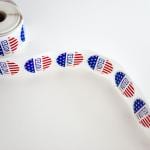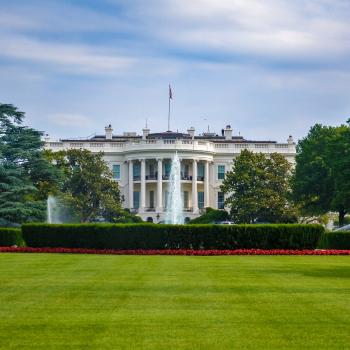
I am not a Donald Trump acolyte. I am ambivalent. I have the evidently antiquated view that that a presidency should be primarily judged by its foreign and military policy, not by domestic goings on (the domestic populace always being fickle). In 2020, because of the pandemic and civil unrest, foreign policy matters even less than it normally does. Terrorism, the only thing that used to make people care about things abroad, isn’t a hot button issue right now (even as there appears to be a spike in extremist activity in France).
Of course, a president who neglects to start any new foreign conflicts and declines to intervene (most of the time) in the domestic affairs of nations discards a useful source of distraction from the dynamics at home. America First has, to some extent—and in conjunction with unforeseeable, disruptive events—turned everyone’s gaze inward, which is not always a welcome development for a first term president. The benefit of nation building is that, as you’re pouring money into trying to make stable democracies appear out of thin air, the contrast between a barely-started-half-way-failing nation and your own makes your citizens appreciative. At the same time, they feel noble for replicating the blessings they enjoy elsewhere. (The framing, and aftermath, of the Iraq invasion is an illustrative case study of this dynamic.)
That being said, on the foreign policy front, I think Trump has performed relatively well (see here, here, here, and here; see also John Yoo and Arthur Herman looking ahead to possibilities if Trump is elected to a second term). He’s not been quite the isolationist everyone expects, but he’s not really a realist or interventionists either. He’s, well, Trump, as in all things.
From the beginning, he seems to be only interested in tangible results/payouts for any and all activity and investments overseas. That’s not necessarily a bad thing, though I think too rigidly holding to that view fails to grasp the influence of so-called soft power and the benefit of maintaining a presence, as they say. (I would have preferred a return to something like Teddy Roosevelt’s disposition adjusted for the present, blended with the earlier versions of liberal interventionism. I think this type of blend, economic pressure backed by a strong military and straightforward negotiations, would have suited Trump.)
Certainly he has not panned out as a fascist dictator (an indispensable, constituting element of which is aggressive territory expansion and through military conquest) as countless think pieces predicted in the lead up to his inauguration (and for a good while after).
Apart from criticisms of Trump’s rhetoric—which we have all gotten used to one way or another—I have yet to hear any convincing, substantive criticism of his foreign policy record. Just last week it was reported that more Middle Eastern nations had joined his peace deal with Israel—a historic feat that even Never Trumpers like David French were forced to acknowledge as a real accomplishment. I think the Trump camp is right to be peeved that the final debate barely touched on foreign policy (contrary to tradition). Focus on the topic would have generally played well for Trump and bad for Biden.
Nor have I heard any meaningful critique of the Trump administration’s COVID-19 response. Joe Biden was unable to produce such analysis in either debate. Monotonously repeating that you would have done better and cut the death toll in half—and unsubstantiated claim— is no rejoinder. And Mike Pence aptly pointed out in his 60 Minutes interview that the incumbent administration has performed every element (with varying success) of the challenger’s proposed pandemic attack plan. But I digress.
What truly puzzles me more than voters (or debate moderators) not taking foreign policy records seriously, is irrational electoral predictions. That is, insistence upon ignoring the lessons of 2016. Instead of looking at traditional indicators, voters and pundits alike should start paying attention to what really matters.
The indicators surveyed below are as variegated and mercurial as the incumbent himself. But they worked in 2016 when nothing else did and they will work again. That being said, 2020 has been a wild year and the natural inclination toward relative societal tranquility matters for this election.
Polls, Briefly
The postmortem of 2016 revealed that data is dead. The pollsters have assured us they will do better but opportunity to justify their profession has not yet been afforded to them, until now. The pollsters have not yet redeemed themselves. Don’t rely on them until they do.
Trafalgar Group is one of the few that got 2016 right. This time around they consistently feature a slimmer lead for Biden nationally than others do, and have given Trump a slight edge over the past few weeks in Ohio, Michigan, and Florida, and only a 2-point lead to Biden in Pennsylvania (more recently, a less-than-full point lead for Trump). (Five Thirty-Eight has designated Pennsylvania the predictor state this year.) (See also this analysis from Eliza Griswold at the New Yorker.) At the end of the day, Trump’s present situation is, at least, comparable to (and, maybe, even better) that of 2016.
Others beside Trafalgar are giving Trump the edge in battleground states (even nationally). However, just because some are leaning toward the incumbent does not mean they’re right, but it could. The fact that the go-to polls and most media outlets are all but calling the election for Biden could suggest that those pollsters who abandon the beaten path are on to something. Time will tell.
Punking the Polls?
The phenomenon of voters lying to pollsters—an occurrence the frequency of which was hotly debated in 2016; its veracity still remains uncertain—is still with us, this time, perhaps, more so. I’m not at all convinced of an intentional, concerted effort to sabotage polls. The evidence is just not there. What I do believe in is people being embarrassed about voting for Trump.
It certainly has not become more socially acceptable to be a Trump supporter. If anything, the incentive (or pressure, rather) to conceal MAGA enthusiasm and Trump loyalty is greater than ever. Some conservatives that started out as Never Trumpers may have since become more comfortable with the President, but such has not been the case amongst liberals. With every day that we draw nearer the election, hatred of, and impatience with, the Orange Man grows on the left. They can see the finish line, or so they think. This is no time to slow down, then.
Consult Contrarians
So pollsters aren’t quite on top of their game. Where do we turn? One important thing to watch is the infinitely more accurate models of certain contrarian academics.
Stony Brook’s Helmut Norpoth successfully predicted 2016 (and 25 of the last 27 elections). He is predicting a repeat for Trump. Per Norpoth’s “Primary Model,” Trump has a 91% of winning and will gather 362 electoral college votes. The same model gave Trump an 87% chance of beating out Hillary last time. Norpoth’s model is, as the name indicates, based on early presidential primary performance. It ignores approval ratings and polling data. This time around, Trump got 85% of the vote in New Hampshire and the closest challenger was Bill Weld with 10%. On the flipside, Biden received only 8.5% of the primary vote in New Hampshire. Norpoth has cited early Democrat indecisiveness and infighting as detrimental to Biden’s primary performance and, by extension, chances at beating Trump. He also discounts variables external to the data like the pandemic. As he said in a recent interview,
“Every president is unique, and I think people get a little carried away with that description. Obama was the first Black president. Is that not unique? If Hillary Clinton had won in 2016, she would have been the first woman president. Is that not unique? I grant that Trump is in many ways a very special kind of character, but I think we also tend to exaggerate that.”
Another contrarian model to watch is Moody’s Analytics. It has correctly predicted every election since 1980 save one, 2016. This time around it predicts Trump winning by an electoral vote split of 304-227. John Antonakis, a professor of organizational behavior at Lausanne University, has also predicted another Trump win, after rightly projecting the 2016 outcome. Antonakis’ model draws on economic conditions, the incumbency effect (which too many people are ignoring), and the relative charisma levels of candidates.
Not all of these types of models predict a Trump win, mind you. Alan Abramowitz, who got 2016 right, forecasts a Biden victory, though narrowly so. Abramowitz—who admits that even he refused to believe his own prediction leading up to 2016—is heavily based on GDP growth rate which, because of the pandemic, is somewhat skewed this time around. That does not discredit the model but rather recognizes that there are, in fact, some unique factors involved in this election.
Pandemic Effect?
The pandemic is doubtless the wildcard for this election. No one knows how to factor in its effects. It certainly has not hurt voter turnout. What we also know is that, for better or worse, its done little to change national approval ratings of Trump’s handling of the virus, or of Trump himself for that matter. Unlike the other blonde-headed mop across the pond, Boris Johnson reaped great benefit from coming down with, and suffering greatly from, COVID-19. The week after his recovery was announced, his approval rating soared by some 20%. Trump received no such love. Doubtless the discrepancy has to do with Johnson’s more successful attempt at humor throughout the whole ordeal and, finally, evident humility in surviving it. By contrast, Trump came across as his usual boastful self; what seemed like genuine attempts at some lightheartedness in the aftermath of his stay at Johns Hopkins fell flat.
All of that being said, the point remains: (polling) data is still dead—it should not serve as the central predictive source—until further notice. Perhaps 2020 will act as a sort of defibrillator. We will see. Until then, we should learn from 2016 and look to the sources that did accurately predict the unpredictable, a Trump victory. The definitive dynamics of 2016 have largely endured and very well may predict another unlikely outcome, a two-term populist president (see above).
Debating Debates
Though polls should generally be disregarded, the recent poll data following the second debate confirm my belief in the last in time rule. That is, only the debate most proximate to election day truly influences voters. All past successes or sins are forgotten. There is no doubt that Trump’s first debate performance did not play well. No one like the excessive combativeness.
But the rule and moderator changes for the final debate played to Trump’s strengths. His timing was much better; he was calmer, etc. And although media polls at the New York Times or Boston Globe more or less called both debates a draw, social media polls tell a different story about the final debate. One poll that was answered by over 370,000 overwhelmingly awarded the victory to Trump. Other social media polls exhibited even more of a commanding lead.
Who won the #Debate?
— Political Polls (@Politics_Polls) September 30, 2020
If my last in time rule is correct, then this matters. Unscientific social media polls may be, but they reach more people than pollsters and the sampling may be even more random. The image of Trump in the final debate, as calm, cool, and collected as his capacity allows, is what will accompany voters into the booth, and that image was overwhelmingly favorable (if Twitter and Facebook mean anything, speaking of which…)
Dig Digital Ads
The first lesson of 2016 is that digital is king. Obama pioneered it, Trump perfected it, and the Democrats still haven’t learned from it. (Read this Mother Jones profile on Brad Parscale, Trump’s former campaign manager, as well as this one from the New Yorker.)
In this regard, 2020 mirrors 2016. Clinton outspent Trump on TV ads back then, but it didn’t matter. Trump beat her on digital (mainly Facebook). Once again, Biden has continued to pour money into traditional ads, but has lagged far behind his opponent on digital. (Both have utilized streaming services a bit.) Trump is betting big on what worked last time, and its not a bad bet. (At one point last year, Trump was outspending every Democrat candidate combined on digital ads.) Should Trump win, the irony will be just as potent this time as four years ago—the guy all our Silicon Valley overlords love to hate learned how to use their tools to win (at that future point) two elections no one thought he had a chance in.
Ogle Google
Staying in digital world, another key predictor of 2016—which has, in truth, proven its reliability since the beginning—is Google search trends. So goes the search, so goes the nation. Since 2004, the candidate that leads in Google searches wins. Its that simple. Obama crushed his opponents in both elections, especially in the final two to three months leading up to the election. But Trump would have blown anyone out of the water, and he wiped the floor with Hillary on this front. And he’s doing it again. The only day that Trump has lagged behind Biden was on Super Tuesday. For the rest of the time between January and March of this year, he enjoyed more than a 70% advantage.
Identity Theft
Doubling down on identity politics has corroded the Democrat identity. They have done nothing to revive their reputation amongst the Rust Belt working class. Rather they have continued to make the new diversity and victimhood game central to their own identity. (This didn’t work in the 2018 midterms, by the way.) Biden is hardly a posterchild for the new identarian brand, but he has fallen in line as best a Catholic septuagenarian can.
At the ABC townhall, he affirmed the “right” of eight and ten-year-old children to transition to the gender that they feel is “best for them” and will “make their life easier.” Biden demonstrated two things: 1) by using “outdated” (and, therefore, offensive) terms and ways of phraseology, that he’s not very capable in this department, but 2) that he is going to toe the new party line on this, the one established just prior to 2016—the one that doubtless contributed to low turnout for Clinton, the disaffection of blue collar areas, and enthusiasm for a wrecking ball like Trump. It was shockingly astute of Trump to point out in both(?) debates that Biden is being left behind in the leftward march of his party.
Which Normal?
Niall Ferguson, per usual, has presented some very sensible, restrained, and historically informed 2020 predictions. Comparing the present election with that of exactly 100 years prior, Ferguson contends that a craving for normalcy typically follows a tumultuous tenure of a populist incumbent. In the case of 1920, the electorate swung back to a milder candidate.
Ferguson thinks, following 6 months of pandemic-induced lockdowns, a fiery summer of civil unrest, and years of bombast from the White House, that people are once again craving normalcy, some respite from the chaos. This may well be the case (only Paul Krugman is dumb enough to take Ferguson’s insight lightly), but the question is whose normalcy do people crave?
To conservatives outside of his ever-loyal base, Trump has never been much more than a blunt force object with which the liberals can be beaten back. The rationale was that letting loose a bull in the Washington china shop, a bull that shared similar, if philosophically underdeveloped, instincts with conservatives, would stifle the liberal advances of the previous eight years.
The question is whether this has changed. I don’t think it has. And this is also where other intangibles come into play. As a recent Washington Examiner article noted regarding the ground game in Wisconsin (which Trump may steal), one candidate is telling people that we are rounding the bend, back to pre-pandemic normal. The other’s message is “We’ve got a long row to hoe.” Which characterization of the future is more appealing? Never mind realism. That’s not what generates enthusiasm. It may sound quaint and childish for Trump to accuse Biden (and the media) of being so negative all the time, but people vote for “hope and change,” not putting their nose to the grindstone and gritting it out.
Again, the question is whether the new, new normal is acceptable to people because, make no mistake, there is no going back. The old normal is as dead as data. The normalcy up for grabs is pre-COVID, pre-riots, pre-looting normal, not the pre-divisive rhetoric, boring politics normal.
The question is also to whom or what voters attribute departure from the normal. Is it Trump’s bombast or the left’s leveraging identity markers to divide us? Biden may not have referred to anyone as a deplorable like Hillary did, but his party has more or less been playing that line on repeat for the past four years, and justifying it by telling the American people that their country is irreparably bigoted, and that they person they put in the White House is the worst of them all. Is that a winning message? In the midst of a pandemic, do people want to hear about their alleged complicity in the real pandemic? Are people tired of Trump’s half-truths and hyperbole or the left’s race-mongering screeds? Especially when those screeds are increasingly spoken in a language the average voter can’t understand. (To be fair, there was certainly something a dueling identity politics dynamic going on in 2016.)
October Surprise for Evangelicals (and Catholics)?
The word is that Biden has been making a late push for evangelicals. Despite the challenger’s claims to the contrary, there is no evidence that he is making any headway amongst white evangelical Protestants. A new evangelical coalition for Biden was announced earlier this month but the effect has been negligible.
The possibly bloated stat of 81% of white evangelicals supporting Trump is still tossed around (see Thomas Kidd on why the state is problematic). But taking that number—it’s probably in the ballpark— as a baseline, the latest numbers from Pew show that 78% of white evangelicals still support Trump whilst only 17% support Biden. This is little-to-no change from 2016.
What is more, it is entirely possible that Trump has gained evangelical support since 2016. A PRRI poll from September showed 79 percent of white evangelicals supporting Trump, a 9-percentage point jump from the same time four years ago. Apart from a slight dip in approval ratings amongst evangelicals in August, their support for Trump has never wavered.
If Biden wanted to chip away at this segment of Trump’s base, then he really should have postponed until after the election announcing his plans to pass the Equality Act within the first 100 days of being in office. The Equality Act would designate sexual orientation and gender identity protected classes under federal civil rights law, a alteration that would present a slew of unfavorable implications for Christian business owners in particular.
If there is one issue that (nearly) rivals that of abortion for evangelicals, its sexual morality—both of these issues feed into the SCOTUS pick-based voting. Biden may not realize it, but he is singlehandedly undermining the moral high ground case being made by sympathetic evangelical voters on his behalf as we speak.
Part of the reason that there was a (slightly) larger turnout for Trump than there was for Romney was because of how objectionable they found Trump’s opponent. Anything Biden does to make himself harder to stomach hurts him in this area. He’s not doing a great job (even though Christianity Today and others are doing their best to bludgeon readers with the “public witness” on his behalf).
Andrew Walker captured the tension introduced by Biden’s announcement perfectly:
Evangelicals for Biden, how does this score on your public witness index? https://t.co/osbVHZR7Yf
— Andrew T. Walker (@andrewtwalk) October 29, 2020
For this reason and many others, as Kate Shellnutt recently discerned, evangelical support of Trump is solid; not only solid but maybe slightly increased since 2016. Not only that, the lesser of two evils argument may be dwindling. Evangelicals are not just voting for Trump, they are (to some extent) enthusiastically doing so—don’t read too much into that word there; the diehard, full-throated evangelical Trump fan is a rare sighting indeed.
The pledge won’t play well with Catholics—who are concentrated in Wisconsin, Michigan, and Pennsylvania and outnumber evangelicals there—either. Just a week ago, the general feel amongst Catholics, at least stateside, regarding the Holy Pontiff’s comments on homosexual civil unions was one of outrage. (If you’re a staff writer at The Atlantic then you probably believe there’s a growing, powerful cadre of anti-Francis, pro-Trump Catholics; probably the same one’s fixing Supreme Court picks through a conspiracy between the Knights of Columbus and the Federalist Society at the behest of Leonard Leo and Bill Barr. Right.)
There’s indication that Trump support is rising amongst white Catholics who, in 2020, may play the role played by evangelicals last time around (i.e. a bit of a swing demographic relative to how heavily they come out for one candidate or the other). As NPR put it recently, “For Trump, Conservative Catholics Are The New Evangelicals.” (Other polls show Trump lagging behind Joe a bit amongst Catholics.)
For that matter, Trump won white Catholics easily in 2016 (as much as 64% of them voted for the Don). Though young white Catholics are typically more moderate than their evangelical counterparts, they have been steadily moving into the “R” column over the past decade. (Probably because of all that dangerous integralist stuff they’re reading from Adrian Vermeule, Gladden Pappin, and Sohrab Ahmari!) Kidding aside, Robert David Sullivan did insightfully point out back in September that (regarding the new, young, Catholic trads), “For those who follow Catholics on social media, it can almost seem as if this year’s presidential election were a mere proxy for a debate over the direction of the church. That is. Catholic voters are not deciding between Donald J. Trump or Joseph R. Biden, Jr.; instead, they are signaling their feelings about Pope Francis or the traditional Latin Mass, with the governance of the United States a secondary concern.” There’s a lot of truth in that, I think (see here).
Biden is doing nothing to help himself with either of these groups. To be sure, evangelical Twitter will continue to writhe in pain and consternation over what to do at the ballot box. Grudem and Piper can trade op-eds. But at the end of the day, the numbers don’t lie. (And by the way, only 22% of adults use Twitter, and Twitter users are far more likely to be Democrats. Fewer than one-in-five Americans get their news from Twitter, and 80% of Tweets are generated by 10% of its users. The platform is a terrible gauge for electoral dynamics.)
True enough, the country is becoming less white and less Christian (white Christians account for only 17% of the population), though they are more likely to show up at the ballot box than other groups. In the future, these demographics will matter less. But for now, they bode well for Trump. The key issue will be how Trump does amongst non-white Catholics. Polls show that, as in evangelicalism, Catholics are divide on Trump along racial lines.
Image credit: @element5digital/Unsplash












